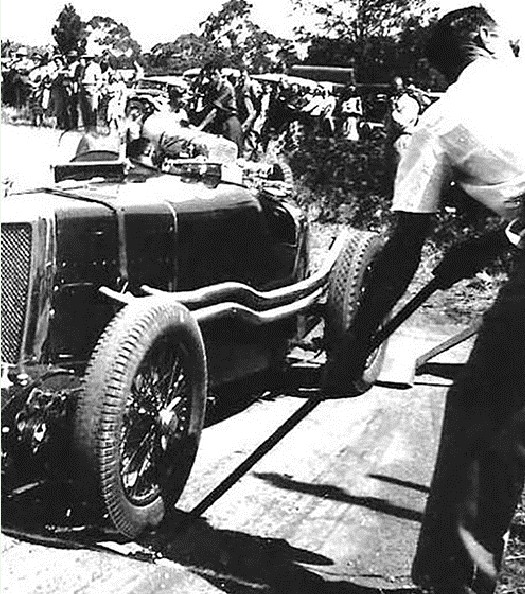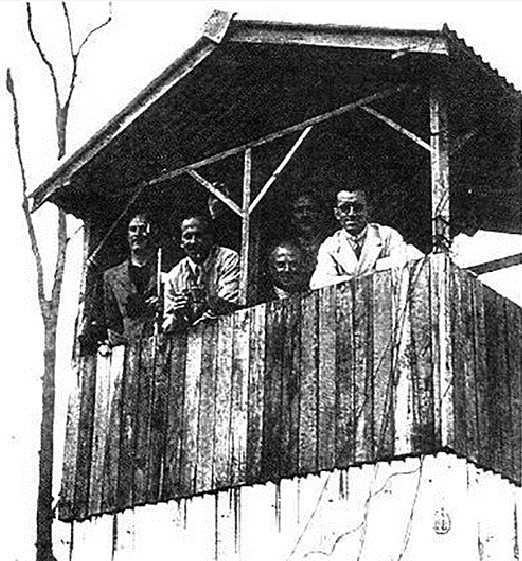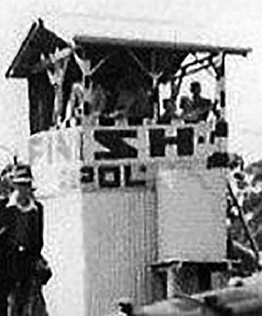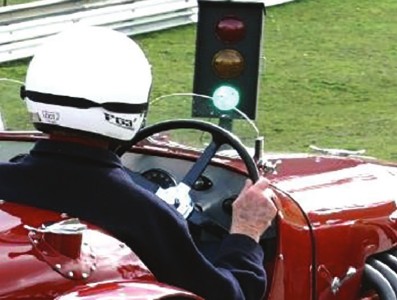
| HOME | CALENDAR | COMPETITOR INFO | SPECTATOR INFO | RESULTS | RECORDS | GALLERY | HISTORY |
| GENERAL HISTORY | ROAD SIGN | PBR BRAKE SHOES | THE ROB ROY BOOK |
| 2023 Site Improvements | TIMING | PRESCOTT HILLCLIMB |
History
of timing at Rob Roy
(reprinted from Vol 54 No. 7 Jul 2017 issue of "Wheel Spin"ROB ROY RETROSPECTIVE - Number 21 in a Series – by David White
A Revolution in Timingwith No Strings Attached
When Rob Roy was in its infancy during the late 1930s and early 1940s, timing of each car was achieved electronically by placing what was known as a ‘timing spoon’ just ahead of the front wheel of the competing car. When underway, the car compressed an upper flexible blade on this spoon to make contact with a fixed blade on a metal rod or ‘wand’ held by the Starter.
The wand was then quickly withdrawn in case the nearside rear wheel of the car also made contact. A ‘chock’ had already been placed behind this rear wheel to stop the car rolling backwards, as the starting grid (as nowadays) sloped slightly to the rear. (see photo).

Cabling installed on a series of poles from the start to the finish line conducted this signal. The time taken by the competing car continued until the car dislodged a length of string stretched across the finish line to a metering device and the ‘clock stopped’. The metering device then needed to be reset after each run.
Obviously, this system had many shortcomings, as delays were frequent, and quite often many cars either broke or carried the string away on a regular basis. The recorded time was then transmitted by telephone via another cable through these same series of poles which linked the timing box to the Public Address system. The respective time was then announced over the PA.
| Jim Akhurst, who was a member of the Light Car
Club of Australia
(LCCA), became involved with this primitive timing system in the early
1940s. He was well aware of its shortcomings, and designed and installed a light beam system at the finish line which was far more accurate and for its time virtually foolproof, and was used successfully for many years. Unfortunately, the posts carrying the lamp and receiving cell at the finish line occasionally got in the way of wayward cars, but ‘not very often’ according to Jim. (Group of people looking at the telephone pole which Lex Davison collided with in December 1947, in his MG.TC Source: State Library Victoria) |
 |
Originally there was a timing box situated at the finish line and early photos seen here indicate its popularity with LCCA Officials. It provided some comfort from the elements and a virtually unrestricted view of the competing cars and on a fine day the Melbourne CBD many miles away.


The other photo indicates a water tank on a wooden structure sitting alongside this timing box and facing the track, which was to feature in “the most exciting incident on the day” for all the wrong reasons in July 1958. Len Lukey in his Cooper Bristol monoposto racing car in just chassis form without its normal body panels and tanks to reduce weight, experienced a jammed throttle coming through Skyline Corner (Turn 2) at very high speed. He continued up the hill fighting for control finally leaving the track to driver’s left, only just missing the timing box and its complement of LCCA Officials, but completely demolishing the adjoining water tank and pole carrying both the timing equipment and telephone cables. The car was almost totally destroyed but Lukey survived virtually unscathed as he was thrown from the car when his seat belt failed on impact. He went on to accept second place in his Class with a time of 28.60 seconds! For safety reasons, I don’t believe either structure remained for very long afterwards,
When the MG Car Club re-established the track in 1992 after an absence of some 30 years, all communication cables were installed underground from the newly restored timing shed to the start and finish lines. The starting spoon was still in use together with a light beam at the finish, and a large electronic stopwatch display was installed for the timing staff.
 In November 2008, Jim Akhurst, then in his 90s, and after an absence of over 50 years, revisited Rob Roy with his son Adrian, and was given a detailed explanation and demonstration of the current state-of-the-art timing system which was designed and constructed by Club Members John Viccars and Ric Collett. Over the years there have been many gradual improvements to the light beams at both the start and finish lines and, of course, computer timing by Ric. Following his visit to Prescott Hillclimb in Gloucestershire in 2011, Ric was given a complete run-down of their timing system and on his return designed and installed our current ‘Traffic Light System’ at the Start Line. Later, another cable was run to the Causeway to indicate split timing to that point, and another beam near the finish line to display the car’s speed through that area. Computer screens were also installed both within and without the Octunda providing details of each current and preceding climbs. This is the system in use today. |
The wonderful photo taken at Rob Roy in April 1947, some (70 years ago) of Lex Davison in his 4½ litre supercharged Bentley about to drive over the finish line and make contact with the string, was obtained, purely by chance, from the State Library of Victoria collection.
The string holder/tensioner and adjacent spare ball of string can be clearly seen in the shadow of the (since removed) timing box.
Acknowledgement to Ric Collett and John Viccars.
Photos – Start Line – David Kusznir; “A History of Rob Roy Hillclimb” by Leon Sims; State Library of Victoria and David White collections
